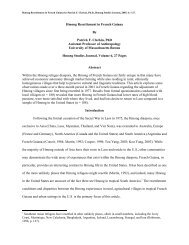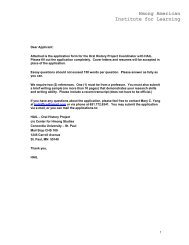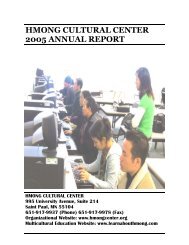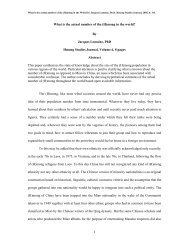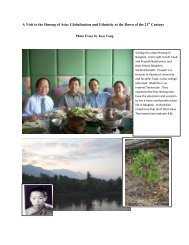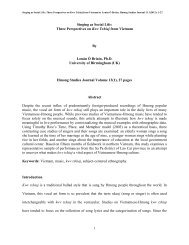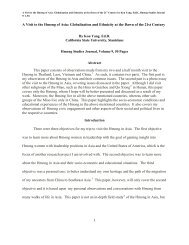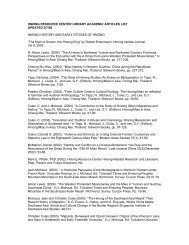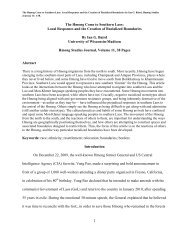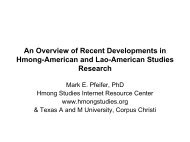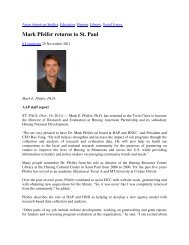Hmong and Lao Refugee Women - Hmong Studies Internet ...
Hmong and Lao Refugee Women - Hmong Studies Internet ...
Hmong and Lao Refugee Women - Hmong Studies Internet ...
You also want an ePaper? Increase the reach of your titles
YUMPU automatically turns print PDFs into web optimized ePapers that Google loves.
<strong>Hmong</strong> <strong>and</strong> <strong>Lao</strong> <strong>Refugee</strong> <strong>Women</strong>: Reflections of a <strong>Hmong</strong>-American Woman Anthropologist by Dia Cha, Ph.D. <strong>Hmong</strong> <strong>Studies</strong> Journal,<br />
2005, 6: 1-35.<br />
be a precursor to the sort of liberating change which would be encountered in an even more pronounced<br />
form in the new life of the immigrant West.<br />
These changes being wrought in camp life affected men no less than women, for in a family<br />
setting the roles played by either gender are inextricably interwoven. In the traditional setting of <strong>Lao</strong>s,<br />
<strong>Hmong</strong> men had largely engaged in farming, fishing, hunting, <strong>and</strong> soldiering. In camp, none of these was<br />
any longer possible. Some men had adapted, taking up a new career more suited to the camp<br />
environment, with its shifting gender roles <strong>and</strong> its cash economy, <strong>and</strong> such activities as jewelry making,<br />
blacksmithing, <strong>and</strong> basket weaving were not uncommon.<br />
These were, of necessity, all small-scale ventures. As an example of the income provided by<br />
such activities, it can be stated that, in the late 1980's, many <strong>Lao</strong> Lum men <strong>and</strong> women in Napho camp<br />
took up silversmithing <strong>and</strong> were enabled thereby to earn in the neighborhood of US $40 to US $50 per<br />
month. Some camp males were also able to take up work in camp services, for which they were<br />
compensated with small allotments of goods. 12<br />
A few men had taken up such occupations – traditionally<br />
designated "women's work" – such as sewing, tailoring, <strong>and</strong> food marketing. Yet, if these activities<br />
yielded small economic return, the political <strong>and</strong> social significance of the shift they represented was great.<br />
In the camps, <strong>Hmong</strong> <strong>and</strong> <strong>Lao</strong> Lum men were no longer able to provide even fifty percent of their<br />
families' basic needs. Rather, <strong>and</strong> via the mechanism of their work with the crafts of embroidery <strong>and</strong><br />
weaving, refugee women had largely become the primary source of family cash income.<br />
Thus it was that the stage was set for the kinds of alterations in gender roles which were to gain<br />
currency <strong>and</strong> speed as traditional ways confronted the modern world. Men <strong>and</strong> boys were increasingly<br />
fetching water <strong>and</strong> caring for children – chores which had previously been allocated to women – while the<br />
12 Although these refugees worked full-time for the organizations <strong>and</strong> officials charged with the provision of camp<br />
services, the refugees received the very nominal monthly compensation of an incentive packet containing shampoo,<br />
toothpaste, soap, <strong>and</strong> detergent. The packet had an approximate retail value of US $4.00, <strong>and</strong> no cash was paid these<br />
workers.<br />
12




